Nursing Leadership: Workplace Violence and Patient Safety
VerifiedAdded on 2022/10/02
|6
|1583
|204
Presentation
AI Summary
This presentation critically evaluates concepts and skills relevant to effective nursing leadership, specifically focusing on optimizing patient safety and creating a healthy workplace, addressing the issue of workplace violence towards nurses. It explores the problem's significance, current efforts to mitigate it, and the role of leadership in resolving it. The presentation also details clinical leadership expectations for new graduate nurses, including scope of practice and ethical boundaries. Furthermore, it emphasizes the importance of knowledge, evidence-based practices, communication, and networking as key elements of effective leadership in the nursing field, offering insights into how these elements contribute to a safer and more supportive work environment for nurses and improved patient outcomes. The presentation references relevant research and policies to support its content.
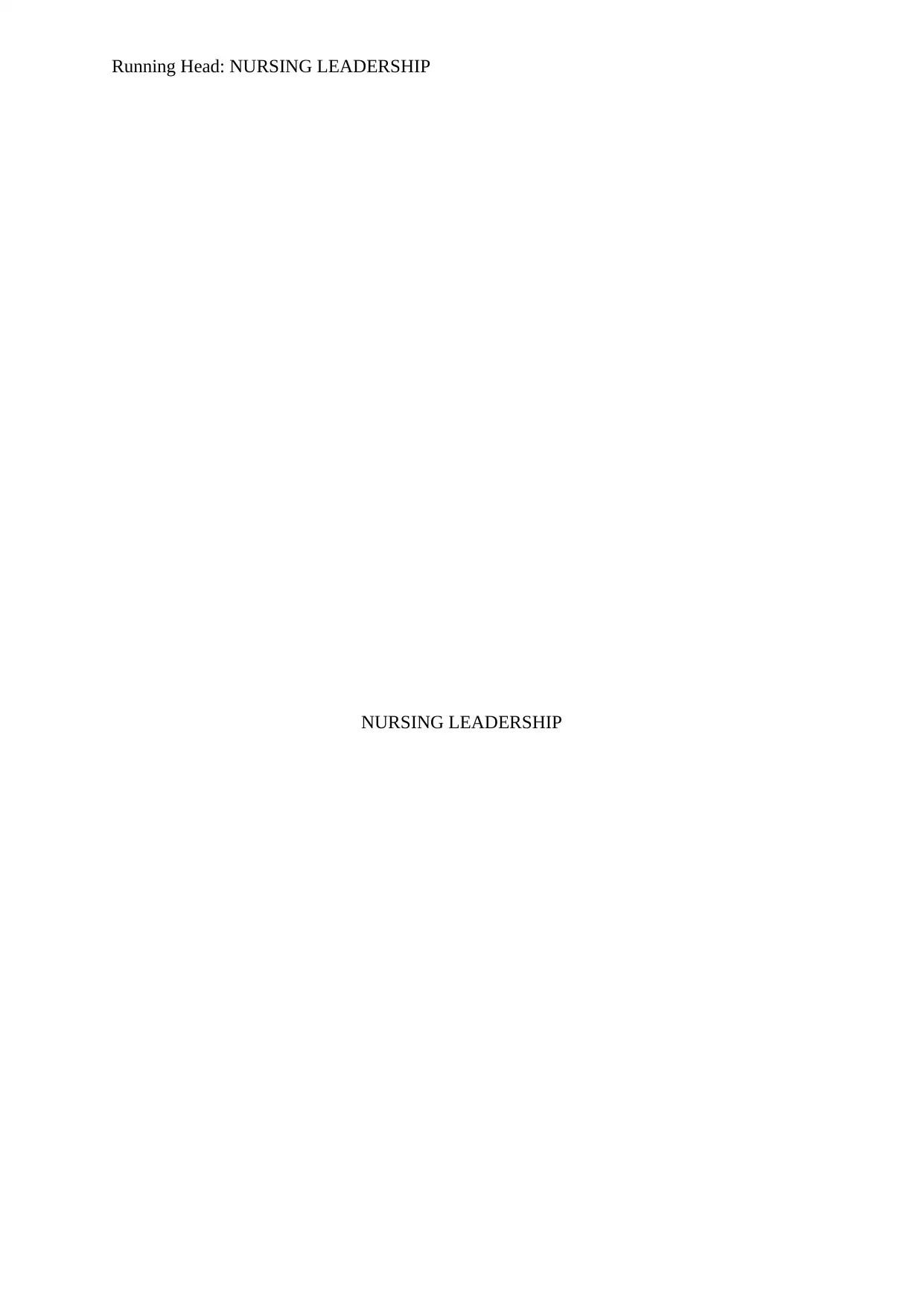
Running Head: NURSING LEADERSHIP
NURSING LEADERSHIP
NURSING LEADERSHIP
Paraphrase This Document
Need a fresh take? Get an instant paraphrase of this document with our AI Paraphraser
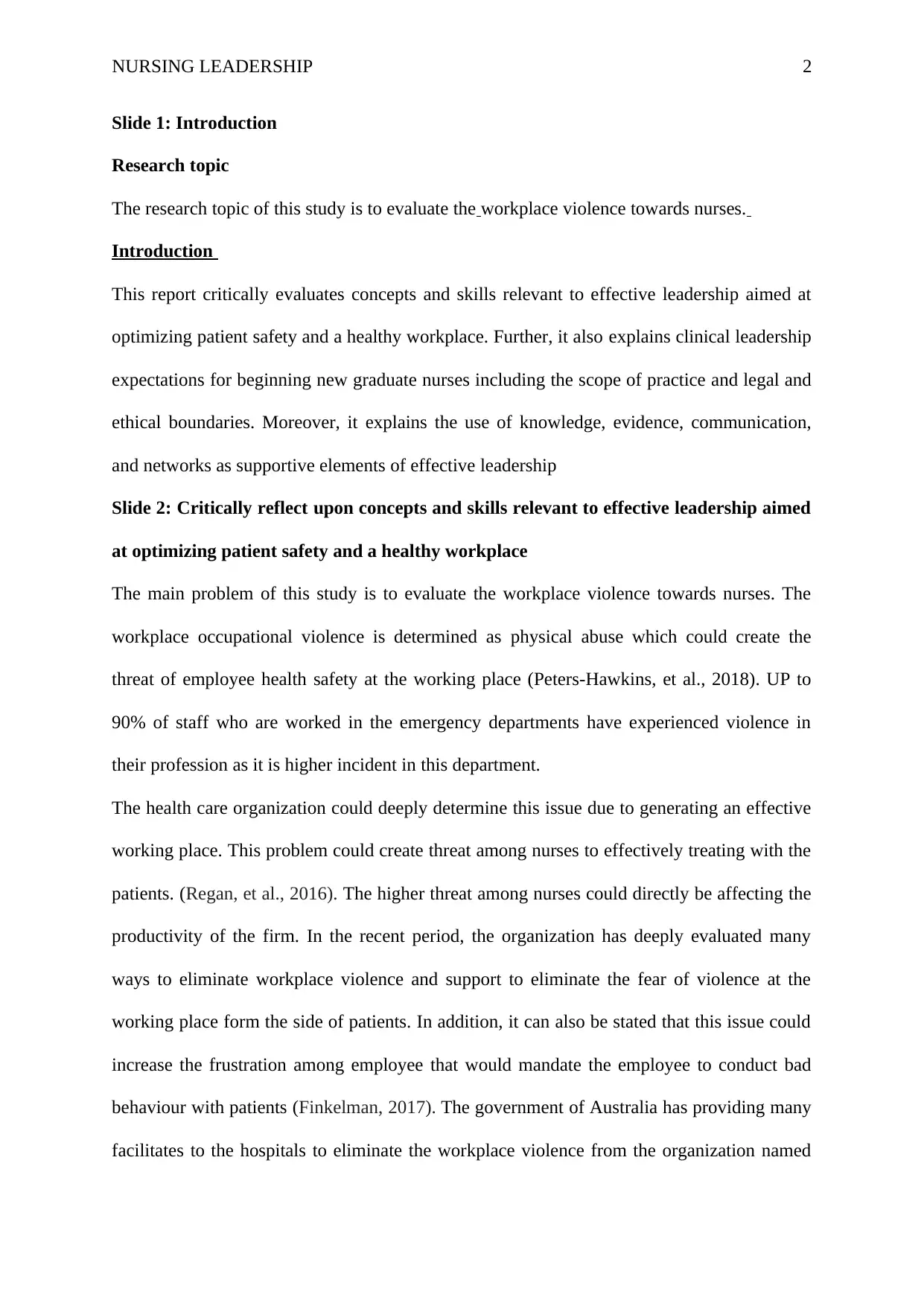
NURSING LEADERSHIP 2
Slide 1: Introduction
Research topic
The research topic of this study is to evaluate the workplace violence towards nurses.
Introduction
This report critically evaluates concepts and skills relevant to effective leadership aimed at
optimizing patient safety and a healthy workplace. Further, it also explains clinical leadership
expectations for beginning new graduate nurses including the scope of practice and legal and
ethical boundaries. Moreover, it explains the use of knowledge, evidence, communication,
and networks as supportive elements of effective leadership
Slide 2: Critically reflect upon concepts and skills relevant to effective leadership aimed
at optimizing patient safety and a healthy workplace
The main problem of this study is to evaluate the workplace violence towards nurses. The
workplace occupational violence is determined as physical abuse which could create the
threat of employee health safety at the working place (Peters-Hawkins, et al., 2018). UP to
90% of staff who are worked in the emergency departments have experienced violence in
their profession as it is higher incident in this department.
The health care organization could deeply determine this issue due to generating an effective
working place. This problem could create threat among nurses to effectively treating with the
patients. (Regan, et al., 2016). The higher threat among nurses could directly be affecting the
productivity of the firm. In the recent period, the organization has deeply evaluated many
ways to eliminate workplace violence and support to eliminate the fear of violence at the
working place form the side of patients. In addition, it can also be stated that this issue could
increase the frustration among employee that would mandate the employee to conduct bad
behaviour with patients (Finkelman, 2017). The government of Australia has providing many
facilitates to the hospitals to eliminate the workplace violence from the organization named
Slide 1: Introduction
Research topic
The research topic of this study is to evaluate the workplace violence towards nurses.
Introduction
This report critically evaluates concepts and skills relevant to effective leadership aimed at
optimizing patient safety and a healthy workplace. Further, it also explains clinical leadership
expectations for beginning new graduate nurses including the scope of practice and legal and
ethical boundaries. Moreover, it explains the use of knowledge, evidence, communication,
and networks as supportive elements of effective leadership
Slide 2: Critically reflect upon concepts and skills relevant to effective leadership aimed
at optimizing patient safety and a healthy workplace
The main problem of this study is to evaluate the workplace violence towards nurses. The
workplace occupational violence is determined as physical abuse which could create the
threat of employee health safety at the working place (Peters-Hawkins, et al., 2018). UP to
90% of staff who are worked in the emergency departments have experienced violence in
their profession as it is higher incident in this department.
The health care organization could deeply determine this issue due to generating an effective
working place. This problem could create threat among nurses to effectively treating with the
patients. (Regan, et al., 2016). The higher threat among nurses could directly be affecting the
productivity of the firm. In the recent period, the organization has deeply evaluated many
ways to eliminate workplace violence and support to eliminate the fear of violence at the
working place form the side of patients. In addition, it can also be stated that this issue could
increase the frustration among employee that would mandate the employee to conduct bad
behaviour with patients (Finkelman, 2017). The government of Australia has providing many
facilitates to the hospitals to eliminate the workplace violence from the organization named
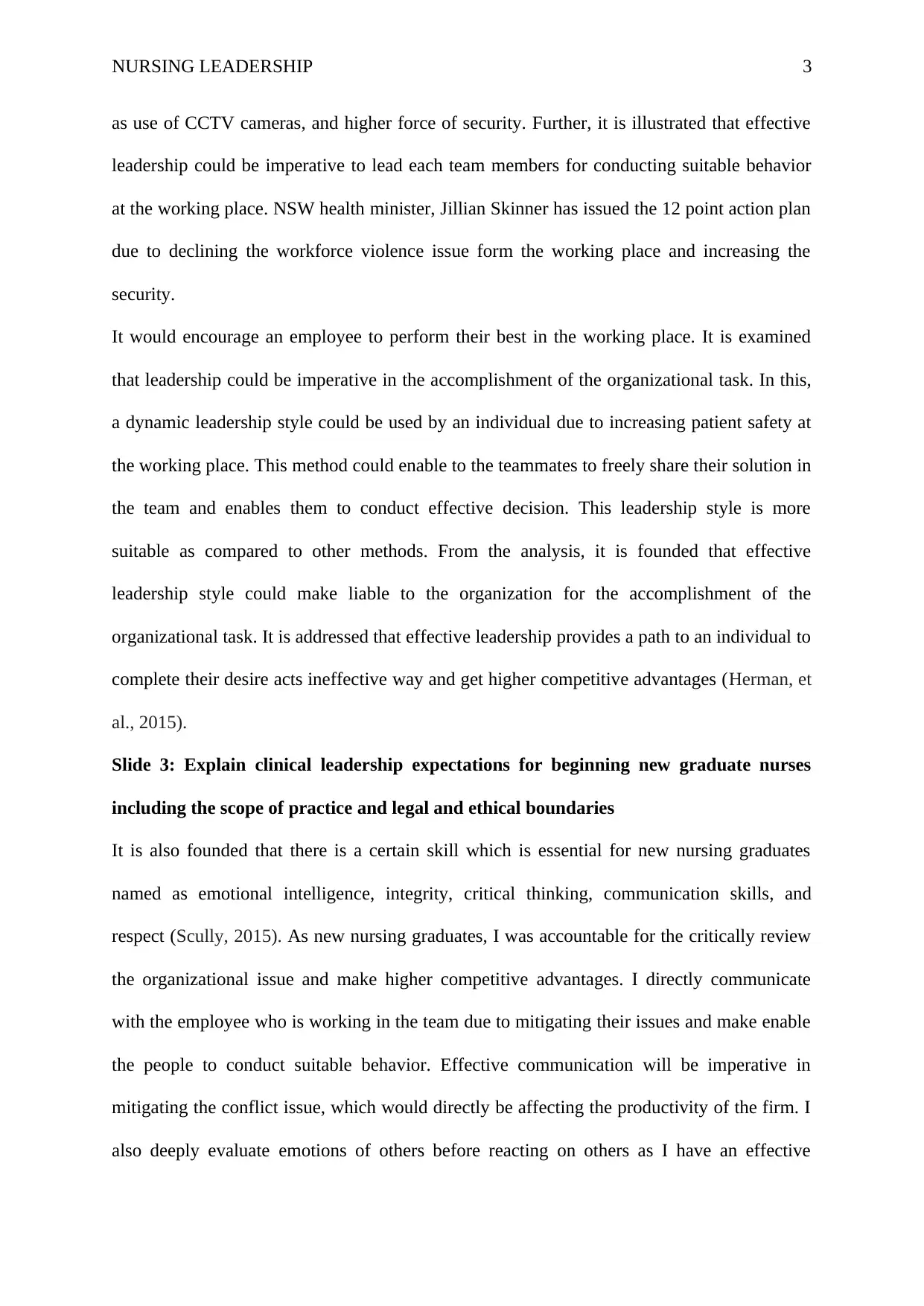
NURSING LEADERSHIP 3
as use of CCTV cameras, and higher force of security. Further, it is illustrated that effective
leadership could be imperative to lead each team members for conducting suitable behavior
at the working place. NSW health minister, Jillian Skinner has issued the 12 point action plan
due to declining the workforce violence issue form the working place and increasing the
security.
It would encourage an employee to perform their best in the working place. It is examined
that leadership could be imperative in the accomplishment of the organizational task. In this,
a dynamic leadership style could be used by an individual due to increasing patient safety at
the working place. This method could enable to the teammates to freely share their solution in
the team and enables them to conduct effective decision. This leadership style is more
suitable as compared to other methods. From the analysis, it is founded that effective
leadership style could make liable to the organization for the accomplishment of the
organizational task. It is addressed that effective leadership provides a path to an individual to
complete their desire acts ineffective way and get higher competitive advantages (Herman, et
al., 2015).
Slide 3: Explain clinical leadership expectations for beginning new graduate nurses
including the scope of practice and legal and ethical boundaries
It is also founded that there is a certain skill which is essential for new nursing graduates
named as emotional intelligence, integrity, critical thinking, communication skills, and
respect (Scully, 2015). As new nursing graduates, I was accountable for the critically review
the organizational issue and make higher competitive advantages. I directly communicate
with the employee who is working in the team due to mitigating their issues and make enable
the people to conduct suitable behavior. Effective communication will be imperative in
mitigating the conflict issue, which would directly be affecting the productivity of the firm. I
also deeply evaluate emotions of others before reacting on others as I have an effective
as use of CCTV cameras, and higher force of security. Further, it is illustrated that effective
leadership could be imperative to lead each team members for conducting suitable behavior
at the working place. NSW health minister, Jillian Skinner has issued the 12 point action plan
due to declining the workforce violence issue form the working place and increasing the
security.
It would encourage an employee to perform their best in the working place. It is examined
that leadership could be imperative in the accomplishment of the organizational task. In this,
a dynamic leadership style could be used by an individual due to increasing patient safety at
the working place. This method could enable to the teammates to freely share their solution in
the team and enables them to conduct effective decision. This leadership style is more
suitable as compared to other methods. From the analysis, it is founded that effective
leadership style could make liable to the organization for the accomplishment of the
organizational task. It is addressed that effective leadership provides a path to an individual to
complete their desire acts ineffective way and get higher competitive advantages (Herman, et
al., 2015).
Slide 3: Explain clinical leadership expectations for beginning new graduate nurses
including the scope of practice and legal and ethical boundaries
It is also founded that there is a certain skill which is essential for new nursing graduates
named as emotional intelligence, integrity, critical thinking, communication skills, and
respect (Scully, 2015). As new nursing graduates, I was accountable for the critically review
the organizational issue and make higher competitive advantages. I directly communicate
with the employee who is working in the team due to mitigating their issues and make enable
the people to conduct suitable behavior. Effective communication will be imperative in
mitigating the conflict issue, which would directly be affecting the productivity of the firm. I
also deeply evaluate emotions of others before reacting on others as I have an effective
⊘ This is a preview!⊘
Do you want full access?
Subscribe today to unlock all pages.

Trusted by 1+ million students worldwide
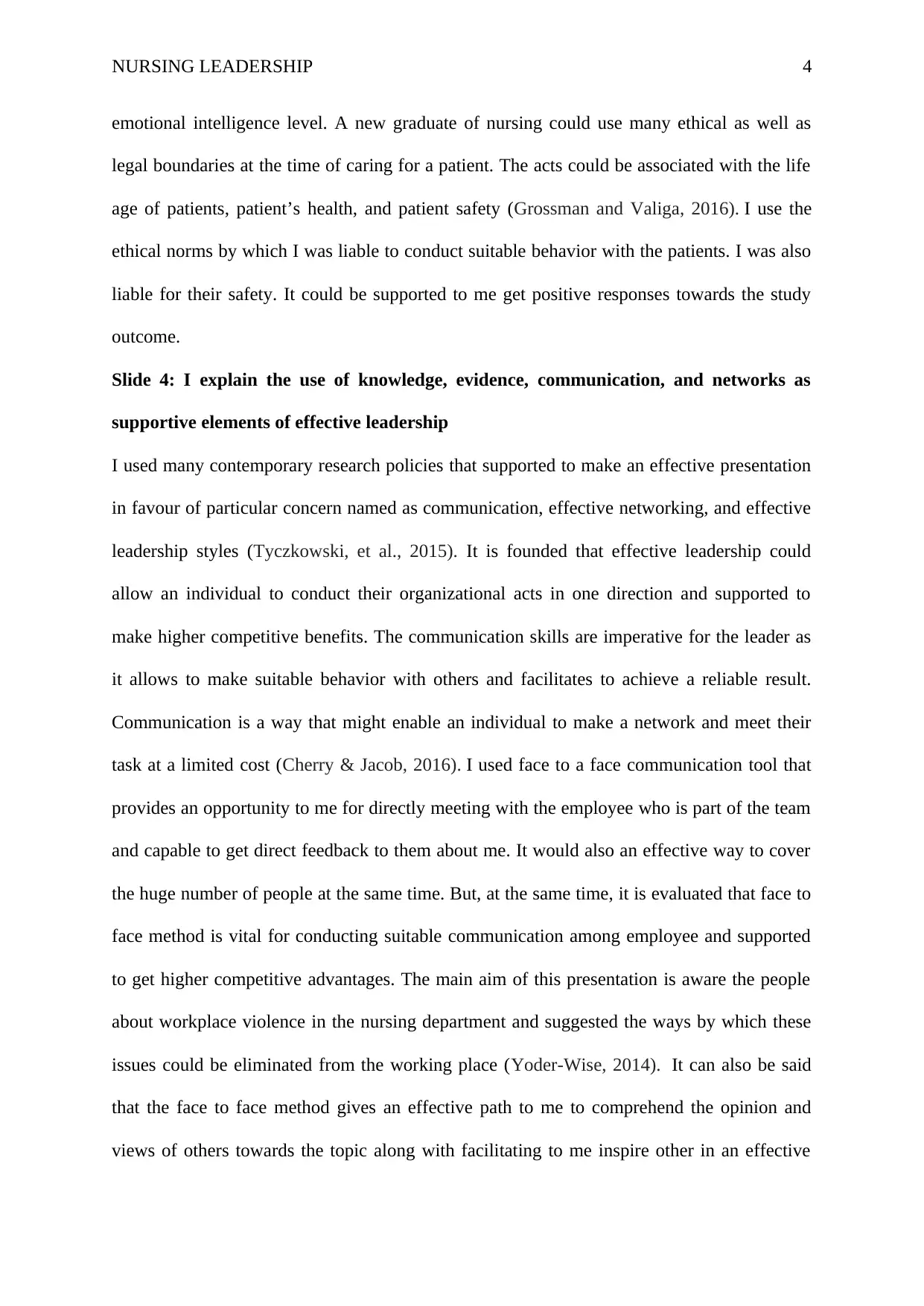
NURSING LEADERSHIP 4
emotional intelligence level. A new graduate of nursing could use many ethical as well as
legal boundaries at the time of caring for a patient. The acts could be associated with the life
age of patients, patient’s health, and patient safety (Grossman and Valiga, 2016). I use the
ethical norms by which I was liable to conduct suitable behavior with the patients. I was also
liable for their safety. It could be supported to me get positive responses towards the study
outcome.
Slide 4: I explain the use of knowledge, evidence, communication, and networks as
supportive elements of effective leadership
I used many contemporary research policies that supported to make an effective presentation
in favour of particular concern named as communication, effective networking, and effective
leadership styles (Tyczkowski, et al., 2015). It is founded that effective leadership could
allow an individual to conduct their organizational acts in one direction and supported to
make higher competitive benefits. The communication skills are imperative for the leader as
it allows to make suitable behavior with others and facilitates to achieve a reliable result.
Communication is a way that might enable an individual to make a network and meet their
task at a limited cost (Cherry & Jacob, 2016). I used face to a face communication tool that
provides an opportunity to me for directly meeting with the employee who is part of the team
and capable to get direct feedback to them about me. It would also an effective way to cover
the huge number of people at the same time. But, at the same time, it is evaluated that face to
face method is vital for conducting suitable communication among employee and supported
to get higher competitive advantages. The main aim of this presentation is aware the people
about workplace violence in the nursing department and suggested the ways by which these
issues could be eliminated from the working place (Yoder-Wise, 2014). It can also be said
that the face to face method gives an effective path to me to comprehend the opinion and
views of others towards the topic along with facilitating to me inspire other in an effective
emotional intelligence level. A new graduate of nursing could use many ethical as well as
legal boundaries at the time of caring for a patient. The acts could be associated with the life
age of patients, patient’s health, and patient safety (Grossman and Valiga, 2016). I use the
ethical norms by which I was liable to conduct suitable behavior with the patients. I was also
liable for their safety. It could be supported to me get positive responses towards the study
outcome.
Slide 4: I explain the use of knowledge, evidence, communication, and networks as
supportive elements of effective leadership
I used many contemporary research policies that supported to make an effective presentation
in favour of particular concern named as communication, effective networking, and effective
leadership styles (Tyczkowski, et al., 2015). It is founded that effective leadership could
allow an individual to conduct their organizational acts in one direction and supported to
make higher competitive benefits. The communication skills are imperative for the leader as
it allows to make suitable behavior with others and facilitates to achieve a reliable result.
Communication is a way that might enable an individual to make a network and meet their
task at a limited cost (Cherry & Jacob, 2016). I used face to a face communication tool that
provides an opportunity to me for directly meeting with the employee who is part of the team
and capable to get direct feedback to them about me. It would also an effective way to cover
the huge number of people at the same time. But, at the same time, it is evaluated that face to
face method is vital for conducting suitable communication among employee and supported
to get higher competitive advantages. The main aim of this presentation is aware the people
about workplace violence in the nursing department and suggested the ways by which these
issues could be eliminated from the working place (Yoder-Wise, 2014). It can also be said
that the face to face method gives an effective path to me to comprehend the opinion and
views of others towards the topic along with facilitating to me inspire other in an effective
Paraphrase This Document
Need a fresh take? Get an instant paraphrase of this document with our AI Paraphraser
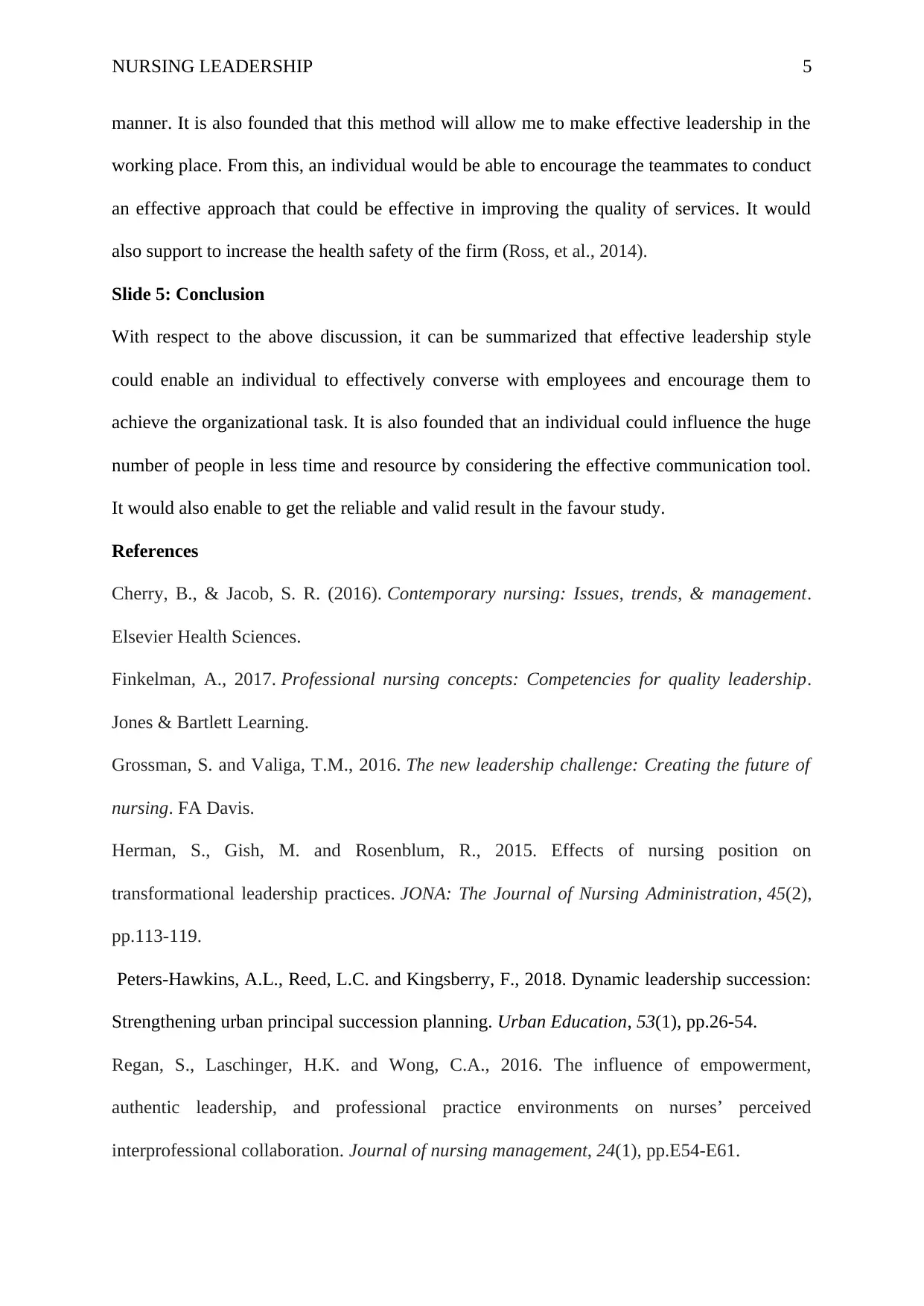
NURSING LEADERSHIP 5
manner. It is also founded that this method will allow me to make effective leadership in the
working place. From this, an individual would be able to encourage the teammates to conduct
an effective approach that could be effective in improving the quality of services. It would
also support to increase the health safety of the firm (Ross, et al., 2014).
Slide 5: Conclusion
With respect to the above discussion, it can be summarized that effective leadership style
could enable an individual to effectively converse with employees and encourage them to
achieve the organizational task. It is also founded that an individual could influence the huge
number of people in less time and resource by considering the effective communication tool.
It would also enable to get the reliable and valid result in the favour study.
References
Cherry, B., & Jacob, S. R. (2016). Contemporary nursing: Issues, trends, & management.
Elsevier Health Sciences.
Finkelman, A., 2017. Professional nursing concepts: Competencies for quality leadership.
Jones & Bartlett Learning.
Grossman, S. and Valiga, T.M., 2016. The new leadership challenge: Creating the future of
nursing. FA Davis.
Herman, S., Gish, M. and Rosenblum, R., 2015. Effects of nursing position on
transformational leadership practices. JONA: The Journal of Nursing Administration, 45(2),
pp.113-119.
Peters-Hawkins, A.L., Reed, L.C. and Kingsberry, F., 2018. Dynamic leadership succession:
Strengthening urban principal succession planning. Urban Education, 53(1), pp.26-54.
Regan, S., Laschinger, H.K. and Wong, C.A., 2016. The influence of empowerment,
authentic leadership, and professional practice environments on nurses’ perceived
interprofessional collaboration. Journal of nursing management, 24(1), pp.E54-E61.
manner. It is also founded that this method will allow me to make effective leadership in the
working place. From this, an individual would be able to encourage the teammates to conduct
an effective approach that could be effective in improving the quality of services. It would
also support to increase the health safety of the firm (Ross, et al., 2014).
Slide 5: Conclusion
With respect to the above discussion, it can be summarized that effective leadership style
could enable an individual to effectively converse with employees and encourage them to
achieve the organizational task. It is also founded that an individual could influence the huge
number of people in less time and resource by considering the effective communication tool.
It would also enable to get the reliable and valid result in the favour study.
References
Cherry, B., & Jacob, S. R. (2016). Contemporary nursing: Issues, trends, & management.
Elsevier Health Sciences.
Finkelman, A., 2017. Professional nursing concepts: Competencies for quality leadership.
Jones & Bartlett Learning.
Grossman, S. and Valiga, T.M., 2016. The new leadership challenge: Creating the future of
nursing. FA Davis.
Herman, S., Gish, M. and Rosenblum, R., 2015. Effects of nursing position on
transformational leadership practices. JONA: The Journal of Nursing Administration, 45(2),
pp.113-119.
Peters-Hawkins, A.L., Reed, L.C. and Kingsberry, F., 2018. Dynamic leadership succession:
Strengthening urban principal succession planning. Urban Education, 53(1), pp.26-54.
Regan, S., Laschinger, H.K. and Wong, C.A., 2016. The influence of empowerment,
authentic leadership, and professional practice environments on nurses’ perceived
interprofessional collaboration. Journal of nursing management, 24(1), pp.E54-E61.
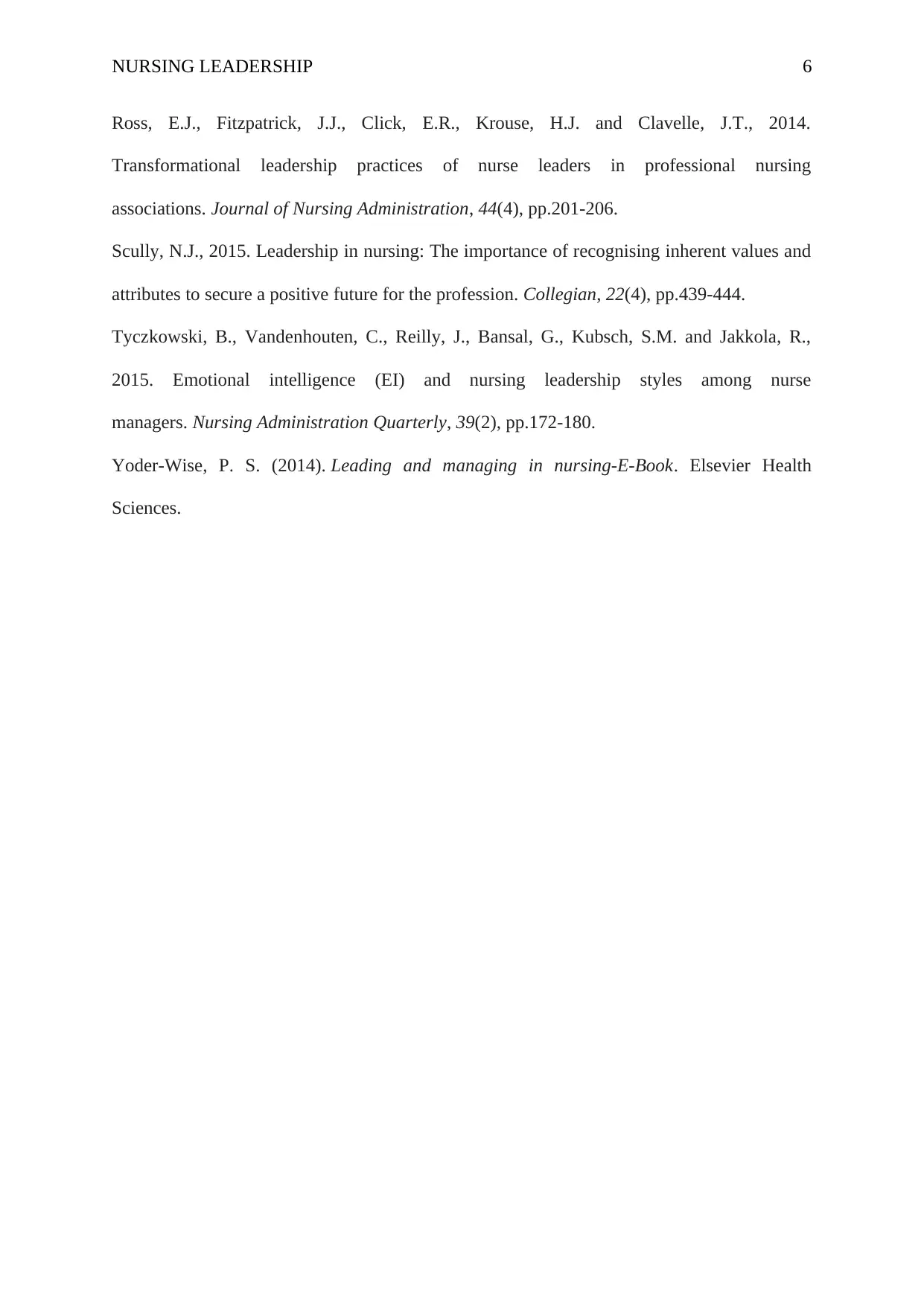
NURSING LEADERSHIP 6
Ross, E.J., Fitzpatrick, J.J., Click, E.R., Krouse, H.J. and Clavelle, J.T., 2014.
Transformational leadership practices of nurse leaders in professional nursing
associations. Journal of Nursing Administration, 44(4), pp.201-206.
Scully, N.J., 2015. Leadership in nursing: The importance of recognising inherent values and
attributes to secure a positive future for the profession. Collegian, 22(4), pp.439-444.
Tyczkowski, B., Vandenhouten, C., Reilly, J., Bansal, G., Kubsch, S.M. and Jakkola, R.,
2015. Emotional intelligence (EI) and nursing leadership styles among nurse
managers. Nursing Administration Quarterly, 39(2), pp.172-180.
Yoder-Wise, P. S. (2014). Leading and managing in nursing-E-Book. Elsevier Health
Sciences.
Ross, E.J., Fitzpatrick, J.J., Click, E.R., Krouse, H.J. and Clavelle, J.T., 2014.
Transformational leadership practices of nurse leaders in professional nursing
associations. Journal of Nursing Administration, 44(4), pp.201-206.
Scully, N.J., 2015. Leadership in nursing: The importance of recognising inherent values and
attributes to secure a positive future for the profession. Collegian, 22(4), pp.439-444.
Tyczkowski, B., Vandenhouten, C., Reilly, J., Bansal, G., Kubsch, S.M. and Jakkola, R.,
2015. Emotional intelligence (EI) and nursing leadership styles among nurse
managers. Nursing Administration Quarterly, 39(2), pp.172-180.
Yoder-Wise, P. S. (2014). Leading and managing in nursing-E-Book. Elsevier Health
Sciences.
⊘ This is a preview!⊘
Do you want full access?
Subscribe today to unlock all pages.

Trusted by 1+ million students worldwide
1 out of 6
Related Documents
Your All-in-One AI-Powered Toolkit for Academic Success.
+13062052269
info@desklib.com
Available 24*7 on WhatsApp / Email
![[object Object]](/_next/static/media/star-bottom.7253800d.svg)
Unlock your academic potential
Copyright © 2020–2025 A2Z Services. All Rights Reserved. Developed and managed by ZUCOL.





